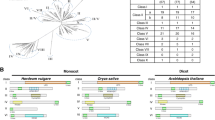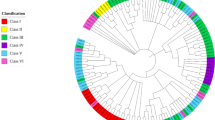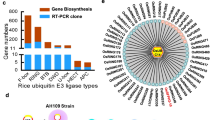Abstract
The E3 ubiquitin ligases are key regulators of protein ubiquitination, which have been shown to be involved in a variety of cellular responses to both biotic and abiotic stresses in eukaryotes. However, the E3 ubiquitin ligase homologues in the soil-borne plant pathogen Plasmodiophora brassicae, the causal agent of clubroot disease of crucifer crops worldwide, remain largely unknown. In this study, we characterized secreted E3 ubiquitin ligases, a group of proteins known to be involved in virulence in many pathogens, in a plasmodiophorid P. brassicae. Genome-wide search in the P. brassicae genome retrieved 139 putative E3 ubiquitin ligases, comprising of 115 RING, 15 HECT, 1 HECT-like, and 8 U-box E3 ubiquitin ligases. Among these E3 ubiquitin ligases, 11 RING, 1 U-box, and 3 HECT were found to harbor signal peptide. Based on published RNA-seq data (Schwelm et al. in Sci Rep 5:11153, 2015), we found that these genes were differentially expressed in distinct life stages including germinating spores, maturing spores, and plasmodia. We characterized one potential secreted E3 ubiquitin ligase, PbRING1 (PBRA_000499). Yeast invertase assay showed that PbRING1 harbors a functional N-terminal signal peptide. PbRING1 also harbors a really interested new gene (RING) domain at its C terminus, which was found to display the E3 ligase activity in vitro. Collectively, this study provides a comprehensive insight into the reservoir of putative secreted E3 ligases in P. brassicae.





Similar content being viewed by others
References
Aist JR, Williams PH (1971) The cytology and kinetics of cabbage root hair penetration by Plasmodiophora brassicae. Can J Bot 49:2023–2034
Alam MA, Kamlangdee N, Kelly JM (2017) The CreB deubiquitinating enzyme does not directly target the CreA repressor protein in Aspergillus nidulans. Curr Genet 63:647–667
Ashida H, Sasakawa C (2017) Bacterial E3 ligase effectors exploit host ubiquitin systems. Curr Opin Microbiol 35:16–22
Bi K, He Z, Gao Z, Zhao Y, Fu Y, Cheng J, Xie J, Jiang D, Chen T (2016) Integrated omics study of lipid droplets from Plasmodiophora brassicae. Sci Rep 6:36965
Boutell C, Sadis S, Everett RD (2002) Herpes simplex virus type 1 immediate-early protein ICP0 and its isolated RING finger domain act as ubiquitin E3 ligases in vitro. J Virol 76:841–850
Bulman S, Richter F, Marschollek S, Benade F, Jülke S, Ludwig-Müller J (2019) Arabidopsis thaliana expressing PbBSMT, a gene encoding a SABATH-type methyltransferase from the plant pathogenic protist Plasmodiophora brassicae, show leaf chlorosis and altered host susceptibility. Plant Biol 21:120–130
Burki F, Kudryavtsev A, Matz MV, Aglyamova GV, Bulman S, Fiers M, Keeling PJ, Pawlowski J (2010) Evolution of Rhizaria: new insights from phylogenomic analysis of uncultivated protists. BMC Evol Biol 10:377
Chai AL, Xie XW, Shi YX, Li BJ (2014) Research status of clubroot (Plasmodiophora brassicae) on cruciferous crops in China. Can J Plant Pathol 36:142–153
Chen H, Chen J, Li M, Chang M, Xu K, Shang Z, Zhao Y, Palmer I, Zhang Y, McGill J, Alfano JR, Nishimura MT, Liu F, Fu ZQ (2017) A bacterial type III effector targets the master regulator of salicylic acid signaling, NPR1, to subvert plant immunity. Cell Host Microbe 22:777–788
Chen T, Bi K, Zhao Y, Lyu X, Gao Z, Zhao Y, Fu Y, Cheng J, Xie J, Jiang D (2018) MAPKK inhibitor U0126 inhibits Plasmodiophora brassicae development. Phytopathology 108:711–720
Chinnusamy V, Zhu J, Zhu JK (2007) Cold stress regulation of gene expression in plants. Trends Plant Sci 12:444–451
Deng F, Guo T, Lefebvre M, Scaglione S, Antico CJ, Jing T, Yang X, Shan W, Ramonell KM (2017) Expression and regulation of ATL9, an E3 ubiquitin ligase involved in plant defense. PLoS One 12:e0188458
Deshaies RJ, Joazeiro CA (2009) RING domain E3 ubiquitin ligases. Annu Rev Biochem 78:399–434
Dixon GR (2009) The occurrence and economic impact of Plasmodiophora brassicae and clubroot disease. J Plant Growth Regul 28:194–202
Djavaheri M, Ma L, Klessig DF, Mithöfer A, Gropp G, Borhan H (2019) Mimicking the host regulation of salicylic acid: a virulence strategy by the clubroot pathogen Plasmodiophora brassicae. Mol Plant Microbe Interact 32:296–305
Downes BP, Stupar RM, Gingerich DJ, Vierstra RD (2003) The HECT ubiquitin-protein ligase (UPL) family in Arabidopsis: UPL3 has a specific role in trichome development. Plant J 35:729–742
Duplan V, Rivas S (2014) E3 ubiquitin-ligases and their target proteins during the regulation of plant innate immunity. Front Plant Sci 5:42
Emanuelsson O, Nielsen H, Brunak S, von Heijne G (2000) Predicting subcellular localization of proteins based on their N-terminal amino acid sequence. J Mol Biol 300:1005–1016
Fang L (2011) Expression and purification of GST-tagged proteins from E. coli. Bio-protocol 1:e132
Feng JIE, Hwang RU, Hwang SF, Strelkov SE, Gossen BD, Zhou QX, Peng G (2010) Molecular characterization of a serine protease Pro1 from Plasmodiophora brassicae that stimulates resting spore germination. Mol Plant Pathol 11:503–512
Feng J, Hwang SF, Strelkov SE (2013) Studies into primary and secondary infection processes by Plasmodiophora brassicae on canola. Plant Pathol 62:177–183
Finn RD, Coggill P, Eberhardt RY, Eddy SR, Mistry J, Mitchell AL, Potter SC, Punta M, Qureshi M, Sangrador-Vegas A, Salazar GA, Tate J, Bateman A (2016) The Pfam protein families database: towards a more sustainable future. Nucleic Acids Res 44:279–285
Freemont PS (2000) RING for destruction? Curr Biol 10:84–87
Ghosh S, Kanwar P, Jha G (2018) Identification of candidate pathogenicity determinants of Rhizoctonia solani AG1-IA, which causes sheath blight disease in rice. Curr Genet 64:729–740
Gietz RD, Schiestl RH (2007) High-efficiency yeast transformation using the LiAc/SS carrier DNA/PEG method. Nat Protoc 2:31–34
Gimenez-Ibanez S, Hann DR, Ntoukakis V, Petutschnig E, Lipka V, Rathjen JP (2009) AvrPtoB targets the LysM receptor kinase CERK1 to promote bacterial virulence on plants. Curr Biol 19:423–429
Gohre V, Spallek T, Haweker H, Mersmann S, Mentzel T, Boller T, de Torres M, Mansfield JW, Robatzek S (2008) Plant pattern-recognition receptor FLS2 is directed for degradation by the bacterial ubiquitin ligase AvrPtoB. Curr Biol 18:1824–1832
Hashimoto M, Murata E, Aoki T (2010) Secretory protein with RING finger domain (SPRING) specific to Trypanosoma cruzi is directed, as a ubiquitin ligase related protein, to the nucleus of host cells. Cell Microbiol 12:19–30
Jacobs KA, Collins-Racie LA, Colbert M, Duckett M, Golden-Fleet M, Kelleher K, Kriz R, LaVallie ER, Merberg D, Spaulding V, Stover J, Williamson MJ, McCoy JM (1997) A genetic selection for isolating cDNAs encoding secreted proteins. Gene 198:289–296
Janjusevic R, Abramovitch RB, Martin GB, Stebbins CE (2006) A bacterial inhibitor of host programmed cell death defenses is an E3 ubiquitin ligase. Science 311:222–226
Jordan T, Schornack S, Lahaye T (2002) Alternative splicing of transcripts encoding Toll-like plant resistance proteins—what’s the functional relevance to innate immunity? Trends Plant Sci 7:392–398
Kageyama K, Asano T (2009) Life cycle of Plasmodiophora brassicae. J Plant Growth Regul 28:203–211
Kamoun S (2003) Molecular genetics of pathogenic oomycetes. Eukaryot Cell 2:191–199
Lee DH, Choi HW, Hwang BK (2011) The Pepper E3 ubiquitin ligase RING1 Gene, CaRING1, is required for cell death and the salicylic acid-dependent defense response. Plant Physiol 156:2011–2025
Letunic I, Doerks T, Bork P (2015) SMART: recent updates, new developments and status in 2015. Nucleic Acids Res 43:257–260
Lorrain C, Petre B, Duplessis S (2018) Show me the way: rust effector targets in heterologous plant systems. Curr Opin Microbiol 46:19–25
Ludwig-Müller J, Jülke S, Geiß K, Richter F, Mithöfer A, Šola I, Rusak G, Keenan S, Bulman S (2015) A novel methyltransferase from the intracellular pathogen Plasmodiophora brassicae methylates salicylic acid. Mol Plant Pathol 16:349–364
Lyda TA, Joshi MB, Andersen JF, Kelada AY, Owings JP, Bates PA, Dwyer DM (2015) A unique, highly conserved secretory invertase is differentially expressed by promastigote developmental forms of all species of the human pathogen, Leishmania. Mol Cell Biochem 404:53–77
Marino D, Peeters N, Rivas S (2012) Ubiquitination during plant immune signaling. Plant Physiol 160:15–27
Michielse CB, Hooykaas PJJ, van den Hondel CAMJJ, Ram AFJ (2005) Agrobacterium-mediated transformation as a tool for functional genomics in fungi. Curr Genet 48:1–17
Nakasone MA, Huang DT (2016) Ubiquitination accomplished: E1 and E2 enzymes were not necessary. Mol Cell 62:807–809
Nakayashiki H, Hanada S, Quoc NB, Kadotani N, Tosa Y, Mayama S (2005) RNA silencing as a tool for exploring gene function in ascomycete fungi. Fungal Genet Biol 42:275–283
Nielsen H (2017) Predicting secretory proteins with SignalP. In: Kihara D (ed) Protein function prediction: methods and protocols. Springer, New York, pp 59–73
Orzalli MH, DeLuca NA, Knipe DM (2012) Nuclear IFI16 induction of IRF-3 signaling during herpesviral infection and degradation of IFI16 by the viral ICP0 protein. Proc Natl Acad Sci USA 109:3008–3017
Petre B, Kamoun S (2014) How do filamentous pathogens deliver effector proteins into plant cells? PLoS Biol 12:e1001801
Prakash C, Manjrekar J, Chattoo BB (2016) Skp1, a component of E3 ubiquitin ligase, is necessary for growth, sporulation, development and pathogenicity in rice blast fungus (Magnaporthe oryzae). Mol Plant Pathol 17:903–919
Qiu J, Sheedlo MJ, Yu K, Tan Y, Nakayasu ES, Das C, Liu X, Luo ZQ (2016) Ubiquitination independent of E1 and E2 enzymes by bacterial effectors. Nature 533:120–124
Rolfe SA, Strelkov SE, Links MG, Clarke WE, Robinson SJ, Djavaheri M, Malinowski R, Haddadi P, Kagale S, Parkin IAP, Taheri A, Borhan MH (2016) The compact genome of the plant pathogen Plasmodiophora brassicae is adapted to intracellular interactions with host Brassica spp. BMC Genom 17:272
Ryu MY, Cho SK, Kim WT (2010) The Arabidopsis C3H2C3-type RING E3 ubiquitin ligase AtAIRP1 is a positive regulator of an abscisic acid-dependent response to drought stress. Plant Physiol 154:1983–1997
Schwelm A, Fogelqvist J, Knaust A, Jülke S, Lilja T, Bonilla-Rosso G, Karlsson M, Shevchenko A, Dhandapani V, Choi SR, Kim HG, Park JY, Lim YP, Ludwig-Müller J, Dixelius C (2015) The Plasmodiophora brassicae genome reveals insights in its life cycle and ancestry of chitin synthases. Sci Rep 5:11153
Schwelm A, Dixelius C, Ludwig-Müller J (2016) New kid on the block—the clubroot pathogen genome moves the plasmodiophorids into the genomic era. Eur J Plant Pathol 145:531–542
Sibbald SJ, Archibald JM (2017) More protist genomes needed. Nat Ecol Evol 1:145
Singh K, Tzelepis G, Zouhar M, Ryšánek P, Dixelius C (2018) The immunophilin repertoire of Plasmodiophora brassicae and functional analysis of PbCYP3 cyclophilin. Mol Genet Genom 293:381–390
Stone SL, Hauksdottir H, Troy A, Herschleb J, Kraft E, Callis J (2005) Functional analysis of the RING-type ubiquitin ligase family of Arabidopsis. Plant Physiol 137:13–30
Wani S, Maharshi N, Kothiwal D, Mahendrawada L, Kalaivani R, Laloraya S (2018) Interaction of the Saccharomyces cerevisiae RING-domain protein Nse1 with Nse3 and the Smc5/6 complex is required for chromosome replication and stability. Curr Genet 64:599–617
Weissman AM, Shabek N, Ciechanover A (2011) The predator becomes the prey: regulating the ubiquitin system by ubiquitylation and degradation. Nat Rev Mol Cell Biol 12:605–620
Williams PH (1966) A system for the determination of races of Plasmodiophora brassicae that infect Cabbage and Rutabaga. Phytopathology 56:624–626
Ye Q, Wang H, Su T, Wu W-H, Chen Y-F (2018) The ubiquitin E3 Ligase PRU1 regulates WRKY6 degradation to modulate phosphate homeostasis in response to low-Pi stress in Arabidopsis. Plant Cell 30:1062–1076
Acknowledgements
This study was supported by National Science Foundation of China (31701773), Natural Science Foundation of Jiangsu Province (BK20170608), “333 project” of Jiangsu Province (BRA2018379), Jiangsu Agricultural Science and Technology Innovation Fund (CX(18)2006), and National Modern Agriculture Industry Technology System (CARS-25).
Author information
Authors and Affiliations
Corresponding authors
Additional information
Communicated by M. Kupiec.
Publisher's Note
Springer Nature remains neutral with regard to jurisdictional claims in published maps and institutional affiliations.
Electronic supplementary material
Below is the link to the electronic supplementary material.
Rights and permissions
About this article
Cite this article
Yu, F., Wang, S., Zhang, W. et al. Genome-wide identification of genes encoding putative secreted E3 ubiquitin ligases and functional characterization of PbRING1 in the biotrophic protist Plasmodiophora brassicae. Curr Genet 65, 1355–1365 (2019). https://doi.org/10.1007/s00294-019-00989-5
Received:
Revised:
Accepted:
Published:
Issue Date:
DOI: https://doi.org/10.1007/s00294-019-00989-5




